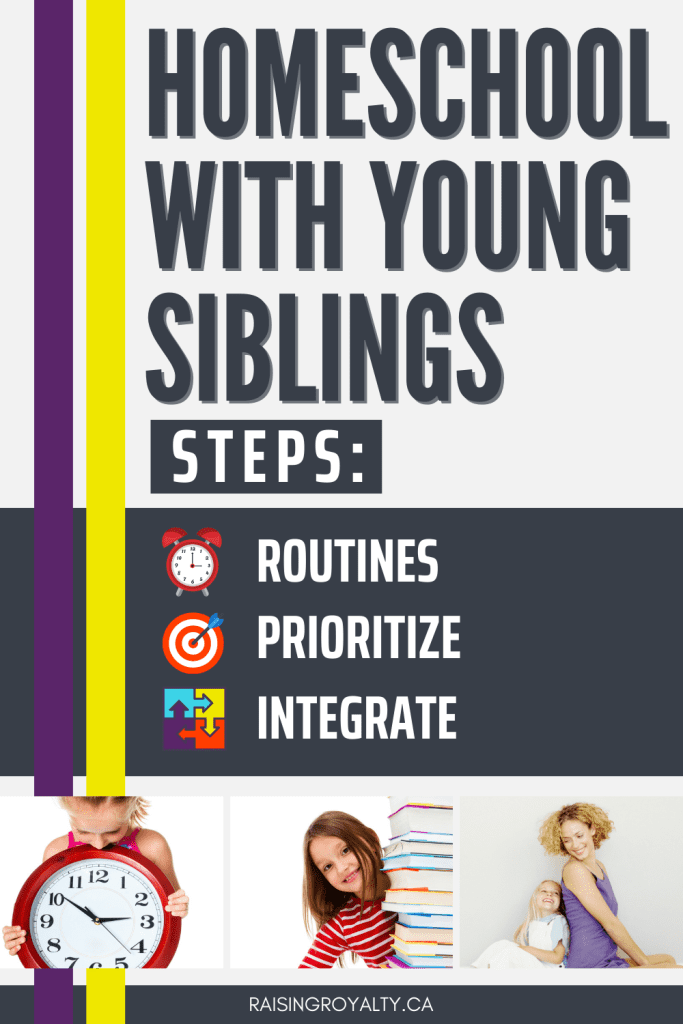

Whether you’ve got a houseful of little ones, or just one very active toddler that seems like a houseful all by themselves, homeschooling can feel impossible. But you can homeschool with younger siblings around.
I had a houseful of small children.
When my divorce was final, I had 4 children 5 and under, and a 10 year old. In order to homeschool my 10 year old, I needed to develop some strategies! I learned about the power of routines, and developed goals and priorities of learning, but most of all, I learned to make learning and homeschooling a lifestyle.
Routines are Essential
The first trick to making a homeschool with younger siblings around work is to develop routines. I’ve talked a lot about how routines are different than schedules, and how routines create space for everything in your day.
The key to a good routine is to anchor it with a key task — like a meal, or bedtime — and build all your other activities around it.
Keep in mind healthy habits. Food, sleep, hygiene and movement breaks are essential to happy, healthy kids — and a happy, healthy mom. Even 5 year olds still benefit from regular nap times, so I strongly encourage you to keep your children napping daily until age 6. They may resist a bit, but if you can move past that resistance and build a habit, you and they will reap immense benefits in their ability to learn, regulate their emotions and listen.
Bonus: when you can build in that daily quiet time for your kids, it will really help with your own mental health and sanity. It’s a survival tactic I would not have managed as well without!
Prioritize What’s Important
Second, choose goals for your homeschooled child. If they are young, focus on the key skills of literacy and math, and add in developmentally appropriate content. For older kids, focus on those skills that are essential to future success — math, communication, research — and look for creative ways to add in the content information they need for the next steps in life (ie college).
For example, if you are homeschooling a 6 year old, focus on phonics, reading for fluency and comprehension, handwriting and basic arithmetic. Then, work on astronomy and backyard science, along with some community exploration and mapwork, and play with colors.
For an older child, such as a 13 year old, prioritize reading for information, note taking, writing reports and pre-algebra or geometry. Then add in human anatomy, national and local history and geography, and include some health, computer or film studies. And a lot of that can be done with online games, documentaries and projects.
Don’t Separate, Integrate.
Finally, once you have a basic flow to your day, and goals for learning, put the two together. The best thing you can do is to try to eliminate in your own mind any lines dividing “school” from “life” or “parenting”. Homeschooling is a way of life, and can be smooth when you avoid artificial separations. And that goes double when you homeschool with younger siblings.
Work with your child’s natural energy and focus.
For example, younger children’s learning times are ideally about 15-20 minutes long at a time. At younger ages, their attention span is limited, so learning activities shouldn’t be big chunks of sit-down, focused work. Break up your learning activities and incorporate them throughout your day.
Here’s a sample schedule for a younger child, ages 5-7.
- Wake up, dress, morning chores.
- Breakfast
- Clean up
- Outside play for 20-40 minutes (weather dependent — shorter if raining/cold, and longer when it’s nice!)
- Inside for snack & reading lesson (try letting them eat while you’re reading to them!)
- Directed play activity related to story (Recommended activity ideas here!) while you do chores/work/settle younger siblings.
- Math lesson and activity at table, while younger children play
- Lunch
- Clean up & nap time (mom gets a much needed break!)
- Wake up with a snack
- Community studies — map work? walk around the neighbourhood? calendar? community helpers? (Recommended activities here!)
- Break for free play outside or inside
- Dinner prep, dinner & clean up (as a family!)
- Color/crafting/art activity while younger siblings are bathed/settled for bed
- Bedtime routine for older child
- Bed
Circadian rhythms play a huge role!
For older children, it’s equally important to work with your child’s natural energy levels. Teens and preteens may need slower mornings, and may be more able to focus in the afternoons and evenings. So you may want to ask them to read or work on math skills in the evenings, when they’re more able to focus, and save less brain-tasking topics for mornings or early afternoons.
One of the best parts about homeschooling is the flexibility. So you can let your teens sleep in! And because they’re older, you can let them be independent in their work. Just make sure you give enough feedback for them to judge progress and help them improve.
Here’s a sample schedule for an older child, 14 years old:
- Wake, dressed, hygiene, morning chores
- Breakfast, clean up
- Exercise & movement breaks (shoo them outside to play sports, go for a run, jogging, biking, etc). You can then focus on younger children — take them outside too!
- Inside for snack break (for everyone) & history documentary — use headphones and a smaller screen if not appropriate for younger ears/eyes.
- Work on science experiment/project — occupy younger children to give teen free space to work uninterrupted.
- Break for lunch, clean up, chores
- Send them to quiet spot with reading — either for pleasure or for school — while you settle younger children for nap. The break will do the entire family good!
- Tech time for writing, online classes, video calls with friends/family — you can then focus on teaching/caring for younger siblings.
- Chores and help with dinner/care for younger siblings/after school job
- Dinner
- Math lesson while younger children play
- Writing assignment/homework while you settle younger children for bedtime
- Online classes/art/film studies
- Downtime for games, social media, friends
- Bed
Homeschool with younger siblings
School activities become part of your whole life, not a separate section of the day. And don’t worry if you don’t get everything on your list done. For children under 7, they learn best through play. And for kids older than that, you’ll be amazed at how much they learn when given the tools and resources to explore their own interests.
When you treat homeschooling as an extension of parenting, your whole family’s life can be much smoother and easier. Learning activities, directed play and assigned learning tasks can be treated the same as chores, family traditions, and other family activities. Homeschool with younger siblings easily when you make it a whole-family affair.
And don’t forget about naptime and quiet time. It’s so important!


